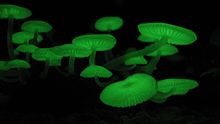Mycena chlorophos
| Mycena chlorophos | |
|---|---|

| |
| In Hachijō-jima botanical park, Japan | |
| Scientific classification | |
| Domain: | Eukaryota |
| Kingdom: | Fungi |
| Division: | Basidiomycota |
| Class: | Agaricomycetes |
| Order: | Agaricales |
| Family: | Mycenaceae |
| Genus: | Mycena |
| Species: | M. chlorophos
|
| Binomial name | |
| Mycena chlorophos (
Sacc. (1887) | |
| Synonyms[1][2] | |
| |
Mycena chlorophos is a species of
Taxonomy
The species was first
In 1860, Berkeley and Curtis described the species Agaricus cyanophos from the material also collected from the Bonin Islands. This material was found near the location that the original specimens of M. chlorophos were found, but a couple of weeks later. Japanese mycologists
In Japan, the mushroom is known as yakoh-take, or "night-light mushroom".[6] In the Bonin Islands, it is called "Green Pepe".[6]
Description
| Mycena chlorophos | |
|---|---|
| Gills on hymenium | |
| Cap is conical or flat | |
| Hymenium is free or adnexed | |
saprotrophic | |
| Edibility is unknown | |
The
The spores are white, smooth, roughly elliptical, and have dimensions of 7–8.5 by 5–6
Similar species
The two other luminescent species of Mycena section Exornatae are similar in appearance to M. chlorophos. M. discobasis fruit bodies have paler caps; microscopically, they have larger spores measuring 9.9 by 6.7 μm, and lack the short apical appendage found on M. chlorophos cheilocystidia. M. margarita has smaller spores averaging 6.9 by 4.4 μm, smaller cheilocystidia, and loop-like clamp connections.[2]
Habitat and distribution
Fruit bodies of Mycena chlorophos are found in forests, where they grow in groups on woody debris such as fallen twigs, branches, and bark.
In Asia, the species has been found in Japan, Taiwan, Polynesia, Java, and Sri Lanka.[8] In Japan, the fungus is becoming more scarce as its natural habits are decreasing.[6] Several Australian field guides have reported the species from that country. The fungus has also been recorded several times from Brazil.[2] Mycena chlorophos was one of several fungi featured in a set of postage stamps issued in Samoa in 1985.[10]
Bioluminescence studies
Since the mushroom is small, and fruits in only a limited season in a small area, researchers have investigated the conditions needed to artificially cultivate the species in laboratory conditions, in order to have more material to study the mechanism of bioluminescence, and to help preserve the species. The optimum temperature for the growth of mycelia is 27 °C (81 °F), while the optimum for the growth of primordia is 21 °C (70 °F). These temperatures are consistent with the subtropical climate in which the species is typically found. Maximum luminescence occurs at 27 °C, and about 25–39 hours after the primordia begin to form, when the cap has fully expanded. At 21 °C, luminescence persists for about 3 days, and becomes undetectable to the naked eyes about 72 hours after primordium initiation.[11]
See also
References
- ^ "Mycena chlorophos (Berk. & M.A. Curtis) Sacc. 1887". MycoBank. International Mycological Association. Retrieved 2012-09-08.
- ^ S2CID 25377671.
- ^ Berkeley MJ, Curtis MA (1860). "Characters of new fungi, collected in the North Pacific Exploring Expedition by Charles Wright". Proceedings of the American Academy of Arts and Sciences. 4: 111–30.
- ^ Saccardo PA. (1887). "Sylloge Hymenomycetum, Vol. I. Agaricineae". Sylloge Fungorum (in Latin). 5: 301.
- S2CID 22546166.
- ^ S2CID 84489071.
- ^ .
- ^ a b Hongo T. (1977). "Higher fungi of the Bonin Islands I" (PDF). Memoirs of the National Science Museum (Tokyo) (10): 31–42.
- PMID 21370386.
- .
- S2CID 83627566.
External links
 Media related to Mycena chlorophos at Wikimedia Commons
Media related to Mycena chlorophos at Wikimedia Commons- Mycena chlorophos in Index Fungorum
